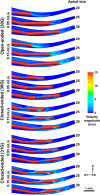Present status and future directions - irrigants and irrigation methods
- PMID: 35338652
- PMCID: PMC9321999
- DOI: 10.1111/iej.13739
Present status and future directions - irrigants and irrigation methods
Abstract
Irrigation is considered the primary means of cleaning and disinfection of the root canal system. The purpose of this review was to set the framework for the obstacles that irrigation needs to overcome, to critically appraise currently used irrigants and irrigation methods, to highlight knowledge gaps and methodological limitations in the available studies and to provide directions for future developments. Organization of bacteria in biofilms located in anatomic intricacies of the root canal system and the difficulty to eliminate them is the main challenge for irrigants. Sodium hypochlorite remains the primary irrigant of choice, but it needs to be supplemented by a chelator. Delivery of the irrigants using a syringe and needle and activation by an ultrasonic file are the most popular irrigation methods. There is no evidence that any adjunct irrigation method, including ultrasonic activation, can improve the long-term outcome of root canal treatment beyond what can be achieved by instrumentation and syringe irrigation. It is necessary to redefine the research priorities in this field and investigate in greater depth the penetration of the irrigants, their effect on the biofilm and the long-term treatment outcome. New studies must also focus on clinically relevant comparisons, avoid methodological flaws and have sufficiently large sample sizes to reach reliable conclusions. Future multidisciplinary efforts combining the knowledge from basic sciences such as Chemistry, Microbiology and Fluid Dynamics may lead to more effective antimicrobials and improved activation methods to bring them closer to the residual biofilm in the root canal system.
Keywords: Activation; delivery; irrigant; sodium hypochlorite; syringe; ultrasonic.
© 2022 The Authors. International Endodontic Journal published by John Wiley & Sons Ltd on behalf of British Endodontic Society.
Conflict of interest statement
The authors have stated explicitly that there are no conflicts of interest in connection with this article.
Figures







References
-
- Abou‐Rass, M. & Patonai, F.J. (1982) The effects of decreasing surface tension on the flow of irrigating solutions in narrow root canals. Oral Surgery, Oral Medicine, Oral Pathology, 53, 524–526. - PubMed
-
- Acteon‐Satelec. (2018) User manual. pp. 19‐28. Available at: https://www.acteongroup.com/en/uploads/media/default/0001/01/a264bc99fb3... [Accessed 2021 Oct 27]
-
- Adcock, J.M. , Sidow, S.J. , Looney, S.W. , Liu, Y. , McNally, K. , Lindsey, K. et al. (2011) Histologic evaluation of canal and isthmus debridement efficacies of two different irrigant delivery techniques in a closed system. Journal of Endodontics, 37, 544–548. - PubMed
-
- Adorno, C.G. , Fretes, V.R. , Ortiz, C.P. et al. (2016) Comparison of two negative pressure systems and syringe irrigation for root canal irrigation: an ex vivo study. International Endodontic Journal, 49, 174–183. - PubMed
-
- Ahmad, M. & Roy, R.A. (1994) Some observations on the breakage of ultrasonic files driven piezoelectrically. Endodontics and Dental Traumatology, 10, 71–76. - PubMed
Publication types
MeSH terms
Substances
LinkOut - more resources
Full Text Sources

